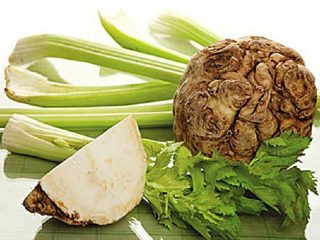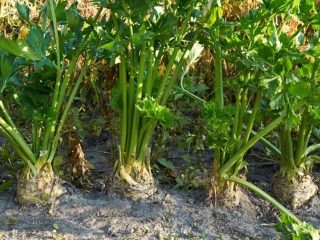Content
Parsley and celery are long-known and well-known herbs, in demand both in cooking and in folk medicine. Outwardly, they are slightly similar, so a non-specialist may mistake one plant for another. But even with a superficial study of the issue, the difference between parsley and celery becomes obvious: there are many more differences than similarities.
Is it the same thing or not?
Both plants belong to the Apiaceae or Celery family. This explains the “superficial” external similarity between them. However, these are two independent genera; therefore, it is a mistake to consider parsley (Petroselinum) and celery (Apium) as different names for the same crop.
What do parsley and celery have in common?
There are many more differences than similarities. The latter, in addition to the botanical classification (both genera are included in the same family), is limited by the shape of the leaves and the slight bitterness in the taste of the greens.
Both plants are important essential oil crops; the richness of their chemical composition determines their demand in cooking, folk medicine and home cosmetology. But on this basis they can be “united” with many cultures.
What is the difference between parsley and celery
Only leaf forms can be confused. It is extremely easy to distinguish the “root vegetables” of celery from parsley. In addition, there is petiole celery (its fleshy, juicy stems are eaten), but parsley does not have this form.
By appearance
A celery bush is approximately 1.5-2 times larger in both height and diameter. The general appearance of the rosette and especially the shape of the leaves are indeed similar, but only at first glance.

Externally, parsley can be described as a smaller and more “elegant” copy of celery
The leaves are heart-shaped, thin, soft to the touch, deeply dissected, and consist of many “finger” fragments. In celery, they are shaped more like a triangle, they feel noticeably rougher, almost leathery. The leaf plates are not so “carved”, the dissection is less deep.
The root varieties of parsley and celery have completely different root vegetables. In the first one they resemble “bleached” carrots, in the second they resemble beets.

To the touch the leaves differ approximately like ordinary writing paper and whatman paper
If the leaves are not cut off, “umbrellas” form at the end of the season. Ripening parsley seeds are similar to dill seeds - the same elongated, grayish-beige. In celery, these are tiny dark brown “balls”.
By smell
The aroma of parsley is soft, unobtrusive, and sweet. The vast majority of people characterize him as pleasant. Celery smells much sharper, “rougher”. Its aroma may well cause rejection.
By application
Plants in fresh and dried form are used in almost every cuisine in the world. Both roots and greens are used.Celery goes especially well with meat, game, poultry, mushrooms, eggs, cheeses, any type of cabbage and legumes.
Parsley is a seasoning close to universal. One can almost certainly say that it will improve the taste of soup, meat dishes, fish, poultry, vegetable side dishes, sauces, savory pastries, and salads.

“Summer” salads with fresh parsley are a real vitamin bomb
Due to its tonic properties and “whitening effect”, parsley is in great demand in home cosmetology. It is also used for:
- oral hygiene;
- appetite stimulation;
- combating excessive sweating;
- “cleansing” of the liver and kidneys;
- normalization of the menstrual cycle in women;
- increasing potency in men.

Juice and crushed roots and greens are added to masks to get rid of wrinkles, age spots, and even out complexion.
Celery is definitely included in the diet of those who want to lose weight. It belongs to foods with the so-called “negative” calorie content - the body spends more energy on its digestion than it receives calories as a result.

Smoothie with apple and lemon juice is one of the most popular recipes
It also has other healing properties that provide:
- normalization of the gastrointestinal tract;
- “mental” recovery from chronic stress, depression, mental overstrain;
- stimulation of water-salt metabolism;
- relief of pain during menstruation;
- reduction in the intensity of symptoms of menopause.

Celery has a very beneficial effect on the nervous system
By chemical composition
In terms of chemical composition, both plants are quite close. Particularly notable are their high concentrations of vitamin C, which is why they can be classified as “anti-aging” herbs. But there are also noticeable differences:
- parsley contains approximately seven times more iron, three times more zinc, 1.5-2 times more magnesium and potassium;
- celery is “richer” in selenium (seven times), sodium and phosphorus (twice);
- Parsley contains much more copper (0.15 mg per 100 g versus 0.01 mg).
According to the rules of cultivation
Different requirements for growing conditions and agricultural technology are explained by the origin of the plants. The original habitat of wild parsley is Southern and Southeast Europe, North Africa (Greece, Spain, the Balkan Peninsula, Algeria, Morocco). The homeland of celery is also the Mediterranean, but it prefers to settle further from the coast, along river beds.
This leads to the main difference in agricultural technology - celery is more moisture-loving than parsley. It is watered approximately twice as often - at least once every 3-4 days. In the heat and in the absence of precipitation, if the substrate is not moistened daily, the leaves quickly begin to turn yellow.

Parsley isn't particularly drought-resistant, but it can survive without water longer than celery.
The more “voluminous” green mass of celery is in greater need of nutrients. It must be planted in fertile soil, and parsley successfully takes root and develops even in a fairly “light” and “poor” substrate.
Celery is especially demanding when it comes to nitrogen content in the soil. At the beginning of the growing season, be sure to carry out 2-3 fertilizing with mineral fertilizers or folk remedies.

Nitrogen is necessary for celery for active growth of green mass.
On average, celery has a shorter growing season than parsley. In case of death of seedlings after return frosts, if otherwise necessary, its seeds can be sown twice per season.
Root celery is successfully cultivated even in northern Russian regions with short summers. Under similar conditions, parsley does not always “have time” to form root crops.
Which is healthier: parsley or celery?
It is impossible to say categorically that parsley is healthier than celery, or vice versa. The healing properties of both plants have been well studied for a long time; their beneficial effects on the body are multifaceted, but at the same time different. Which greens to include in your diet depends on the desired effect.
“Treatment” with parsley in folk medicine is most often prescribed for an inflammatory process or infection in the body, a tendency to allergic reactions, hypertension, the need to restore immunity, and problems with the musculoskeletal system.
Parsley is beneficial for both women and men. For the first, it helps to normalize the menstrual cycle, for the second, it helps to increase libido and increase the number of viable sperm. In addition, it is a powerful natural aphrodisiac.
Fresh herbs and parsley roots are very rich in vitamins:
- WITH;
- TO;
- E;
- RR;
- AT 9;
- AT 2.
It is not recommended to include parsley in the diet of pregnant women - it increases the tone of the uterine muscles
In terms of the “power” of its healing effect on the body, celery is equated to ginseng. It is especially valued for its general strengthening effect. The daily inclusion of celery in the diet helps maintain immunity, ensures the prevention of vitamin deficiency and “seasonal” diseases. But at the same time, compared to parsley, it has many more contraindications and restrictions on consumption.
Celery has the ability to normalize blood sugar levels, so it is recommended for patients with diabetes. It will be useful for problems with concentration and memory, physical and mental exhaustion.
Conclusion
The difference between parsley and celery is obvious to anyone who is even minimally familiar with these plants. They differ noticeably not only visually, but also in taste and smell. Both cultures are characterized by a rich chemical composition, so they are consistently in demand in cooking and folk medicine. But the beneficial effect on the body goes in different directions.
https://youtu.be/N6p7tTipMrY








